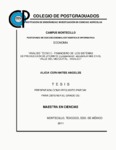Análisis técnico-financiero de los sistemas de producción de jitomate (Lycopersicon esculentum Mill) en el Valle del Mezquital, Hidalgo
Abstract
Se caracterizaron los sistemas de producción de jitomate en el Valle del Mezquital, Hidalgo; identificando a cuatro siendo: a) cielo abierto, y en invernadero con tres variantes b) producido en suelo (camas), c) en tezontle (bolsa) y d) mezcla de sustratos (tezontle-composta en bolsa), este último sistema se propuso y desarrolló experimentalmente en esta investigación. Para el análisis de cada método de producción se utilizó el muestreo no probabilístico “bola de nieve” (Cornelius, 1981) para identificar a los productores a quienes se les aplicaron entrevistas. El cuestionario incluyó una sección de características productivas, tecnológicas, de comercialización y económicas. Se encontró que los cuatro sistemas presentaron notables diferencias en todos los aspectos; técnicamente: el sistema más eficiente fue el intensivo bajo condiciones de invernadero debido al control que se tiene de los factores ambientales (humedad relativa, temperatura, radiación, entre otros), polinización e incidencia de plagas y enfermedades. En productividad considerando una misma superficie de tierra, el de mayor rendimiento fue de invernadero; y dentro de ellos el de mezcla de sustratos con 12 kg/m2, los frutos obtenidos fueron uniformes y de mayor tamaño, comparado con el sistema de tezontle y en suelo que en promedio produjeron 11 kg/m2 cada uno. Financieramente todos los sistemas fueron rentables obteniendo un Valor Actual Neto de $35,060.3 pesos (00/100 M.N.) en campo, $187,352.7 en camas, 171,782.5 en tezontle y 195,319.4 mezcla de sustratos; la Relación Beneficio-Costo con recursos propios fue de 1.08 campo, de 1.43, 1.45 y 1.50 pesos para los sistemas de invernadero en suelo, tezontle y mezcla de sustratos respectivamente. Se concluye que la producción en invernadero es más rentable aunque la inversión inicial es mayor y requiere de conocimiento técnicos. _______________ TECHNICAL-FINANCIAL ANALYSIS OF PRODUCTION SYSTEMS FOR TOMATO (Lycopersicon esculentum Mill) AT VALLE DEL MEZQUITAL, HIDALGO, MÉXICO. ABSTRACT: Production systems for tomato at Valle del Mezquital, Hidalgo were characterized, and the following two were identified: 1) on the field, and 2) greenhouse, with three variations: a) directly produced on soil (beds); b) whith tezontle as main substratum and c) a mixture of substratum (tezontle-bagged compost). This last system was experimentally proposed and developed in this research. For the analysis of each method, non-probability “snowball” sampling was used (Cornelius, 1981) to identify producers to whom interviews were applied. The questionnaire included a section of productivity, technology, marketing and finances characteristics. It was found that the four systems presented noticeable differences in every aspect. Technically, the most efficient was the intensive system under greenhouse conditions due to the possibility to control environmental factors (relative humidity, temperature, radiation, among others), pollination and occurrence of plagues and diseases. Terms of productivity, considering a similar surface of land, the system that yielded the most was greenhouse, and within this one the mixture of substratum at 12kg/m² produced which of tomatoes that were the most uniform and bigger-sized compared to the tezontle system which produced 11 kg/m². Financially, all systems were profitable, with a net present value (NPV) of $35,060.3 on field, $187,353 on layers, $171,782 on tezontle and $195,319.4 with a substratum The cost-benefit relation where own resources was 1.08 on the field, and 1.43, 1.45 y 1.5 pesos for greenhouse on tezontle and substratum a mixture of respectively. As a conclusion greenhouse production was the most profitable in comparation to the conventional system, even though initial investment was higher and technical.
Collections
- Tesis MC, MT, MP y DC [263]

